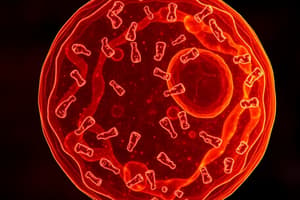Podcast
Questions and Answers
How are prokaryotic ribosomes structured?
How are prokaryotic ribosomes structured?
Prokaryotic ribosomes are constructed from proteins and ribosomal RNA (rRNA), with a size of 70S.
What is the function of ribosomes in prokaryotic cells?
What is the function of ribosomes in prokaryotic cells?
Ribosomes function as a workbench for protein synthesis (translation).
How do ribosomes contribute to protein synthesis in prokaryotic cells?
How do ribosomes contribute to protein synthesis in prokaryotic cells?
Ribosomes join amino acids to form a polypeptide chain during protein synthesis.
What is the purpose of inclusions in prokaryotic cells?
What is the purpose of inclusions in prokaryotic cells?
What distinguishes prokaryotic ribosomes from eukaryotic cytoplasmic ribosomes?
What distinguishes prokaryotic ribosomes from eukaryotic cytoplasmic ribosomes?
Study Notes
Prokaryotic Ribosome Structure
- Prokaryotic ribosomes are composed of two subunits: a small 30S subunit and a large 50S subunit.
- The 30S subunit is made up of a 16S rRNA molecule and 21 proteins.
- The 50S subunit is comprised of a 5S rRNA, a 23S rRNA, and 34 proteins.
Prokaryotic Ribosome Function
- Ribosomes are essential for protein synthesis in prokaryotic cells.
- They act as the site of translation, where mRNA is decoded into a polypeptide chain.
Protein Synthesis Process
- The mRNA binds to the 30S subunit, positioning the start codon at the P-site.
- The initiation complex, consisting of the 30S subunit, mRNA, and initiator tRNA, then joins with the 50S subunit to form a complete ribosome.
- The tRNA molecules carrying specific amino acids enter the A-site, and peptide bonds are formed between the amino acids.
- The ribosome moves along the mRNA, reading codons and adding amino acids to the growing polypeptide chain.
Prokaryotic Inclusions
- Prokaryotic cells can store various substances within inclusions, which are non-membrane-bound compartments.
- These inclusions can store nutrients like glycogen or polyhydroxybutyrate, provide buoyancy with gas vesicles, or store inorganic compounds like sulfur granules.
Distinguishing Prokaryotic and Eukaryotic Ribosomes
- Prokaryotic ribosomes are smaller than eukaryotic cytoplasmic ribosomes (70S vs 80S).
- Prokaryotic ribosomes have a distinct sedimentation coefficient (Svedberg unit) compared to eukaryotic ribosomes.
- This difference in size and sedimentation coefficient arises from the rRNA and proteins present in each type of ribosome.
Studying That Suits You
Use AI to generate personalized quizzes and flashcards to suit your learning preferences.
Description
Test your knowledge about cellular inclusions like volutin granules and storage forms of carbon, as well as the structure and characteristics of chromosomes in cell biology.




